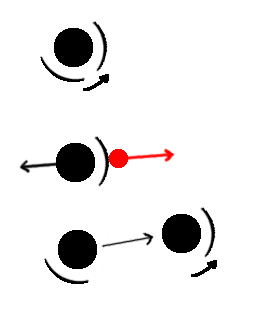I'm trying to rotate an object (shield) around another object (player) like this question.
My use-case is this: I have players moving around a field. Their respective shield is orbiting in a constant velocity around them. If a "ball"-object (red) touches a player, he's dead. A player can use his shield to deflect a "ball". When a shield collides with the "ball", I want the player and shield be affected by the collision; thus the player should bounce back, keeping the shield at the same distance. Alternatively, on colliding with the "ball" the shield could act like a static object, either way would be okay with me.
I tried connecting the player to the shield via a b2DistanceJoint and
applying a force to the shield (orthogonal to the line between center of player and center of shield i.e. if the shield is right of the player, the force acts downwards; if the shield is below the player, the force acts to the left). This made the shield rotate, but the player's position was affected by the rotation, which resulted in wobbling. Then, I tried changing the density of the shield to turn down the effect on the player, but then the collision with the "ball" was faulty as the ball had way more mass.
"teleporting" the shield to the right position, but the collision with the "ball" was faulty afterwards (the ball "stuck" to the shield)
I know my whole setup is not a realistic physics model, so is there a way to achieve this behaviour in Box2D?
b2Body* body;
{
b2BodyDef bodyDef;
bodyDef.type = b2_dynamicBody;
bodyDef.position.Set(gameToWorld * x, gameToWorld * y);
body = world.CreateBody(&bodyDef);
// Define another box shape for our dynamic body.
b2CircleShape circle;
circle.m_p.Set(0, 0);
circle.m_radius = gameToWorld * bodyRadius;
// Define the dynamic body fixture.
b2FixtureDef fixtureDef;
fixtureDef.shape = &circle;
// Set the box density to be non-zero, so it will be dynamic.
fixtureDef.density = 1;
// Override the default friction.
fixtureDef.friction = 0.0f;
fixtureDef.restitution = 1.0f;
// Add the shape to the body.
body->CreateFixture(&fixtureDef);
}
b2Body* shield;
{
b2BodyDef bodyDef;
bodyDef.type = b2_dynamicBody;
bodyDef.position.Set(gameToWorld * x, gameToWorld * y);
shield = world.CreateBody(&bodyDef);
// Define another box shape for our dynamic body.
b2PolygonShape rect;
// HERE:
rect.SetAsBox(1, 1, b2Vec2(0, 0), 45);
// Define the dynamic body fixture.
b2FixtureDef fixtureDef;
fixtureDef.shape = ▭
// Set the box density to be non-zero, so it will be dynamic.
fixtureDef.density = 1;
// Override the default friction.
fixtureDef.friction = 0.0f;
fixtureDef.restitution = 1.0f;
// Add the shape to the body.
shield->CreateFixture(&fixtureDef);
}
{
b2DistanceJointDef def;
def.bodyA = body;
def.bodyB = shield;
def.length = 0;
world.CreateJoint(&def);
}

